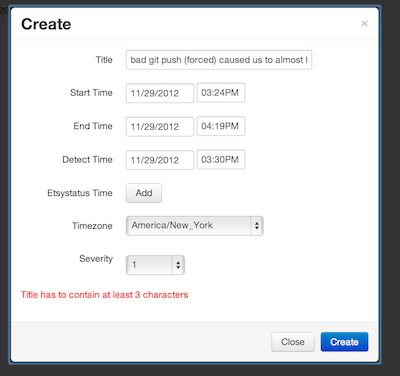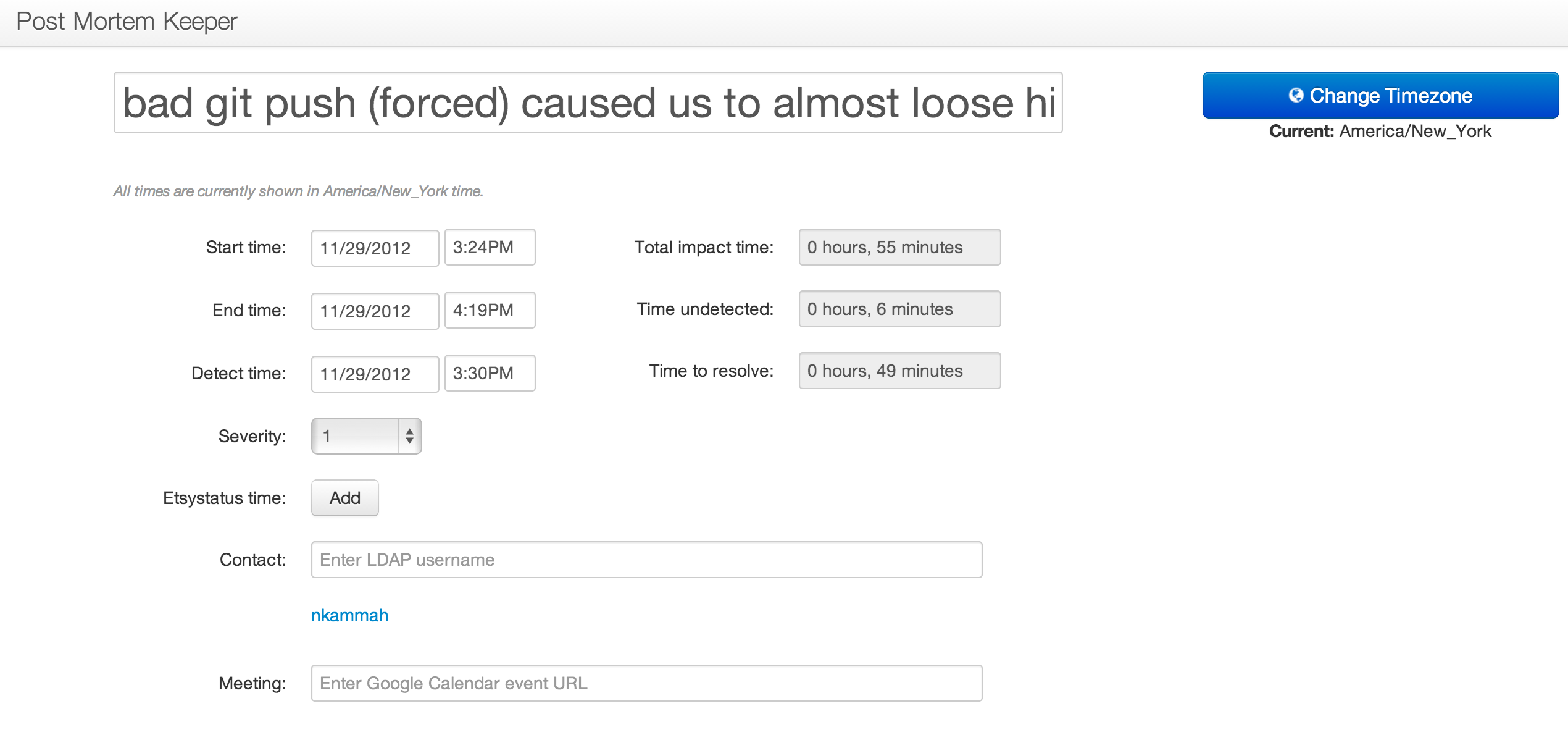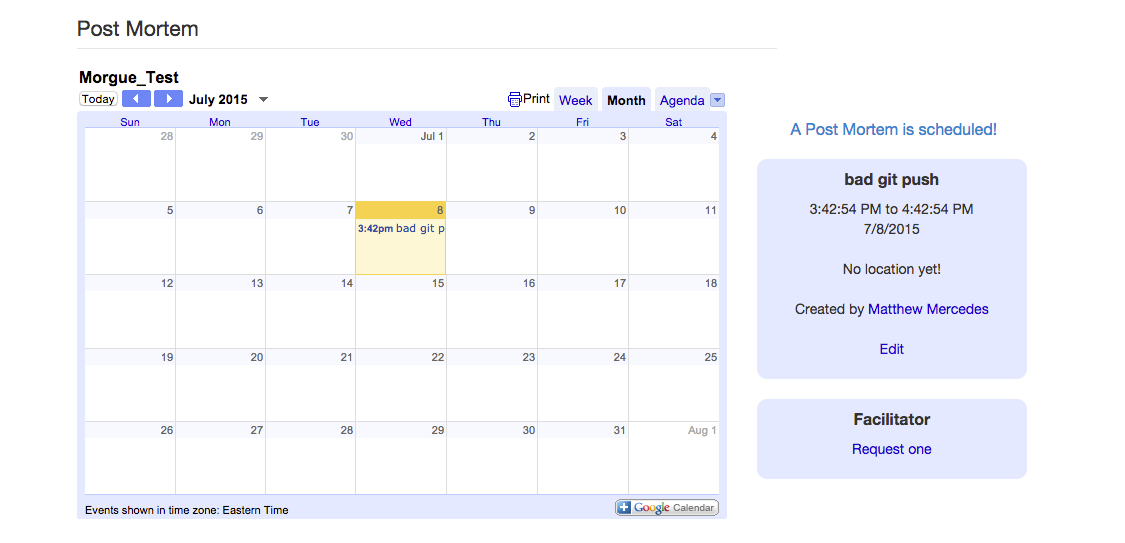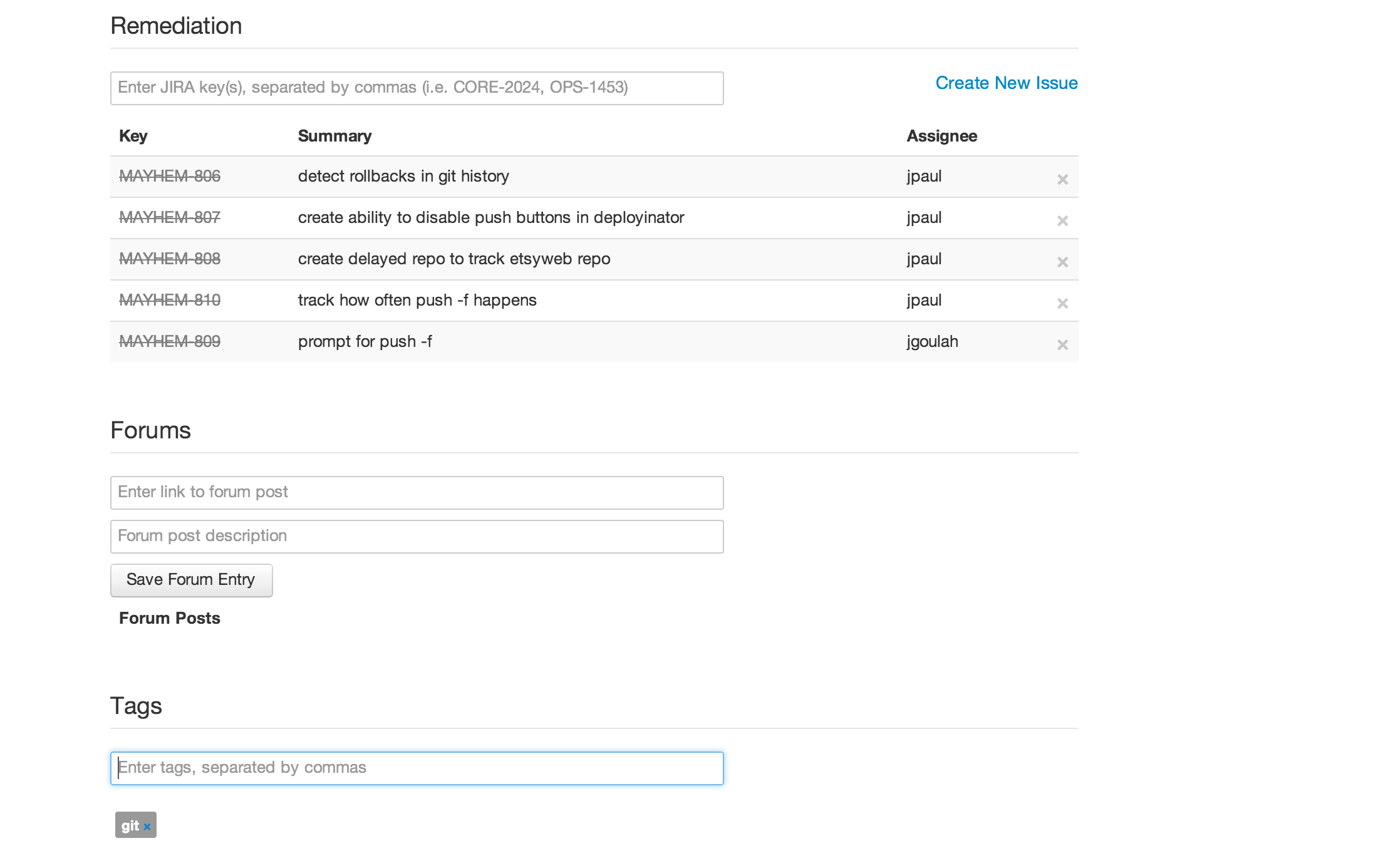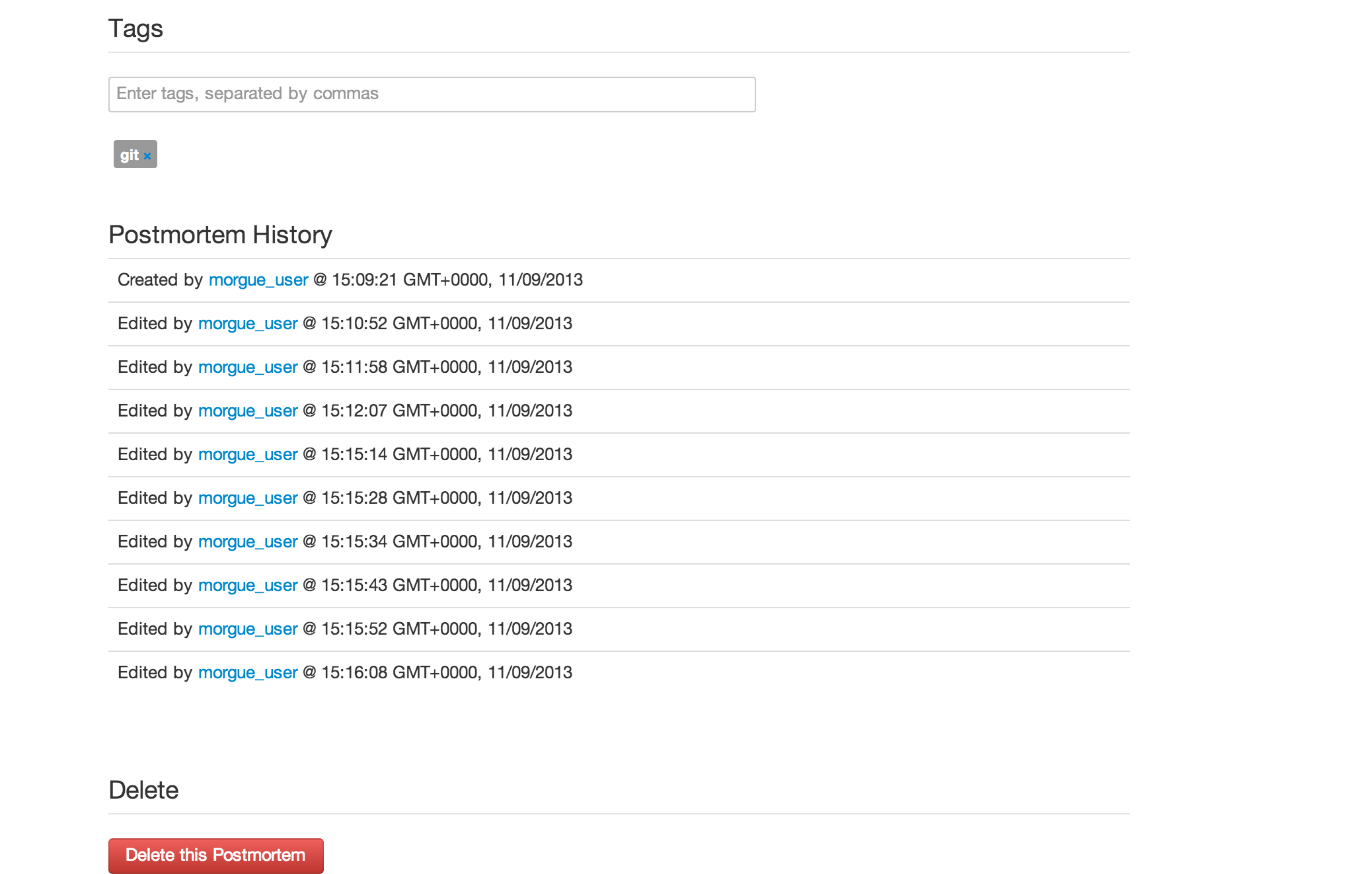This is a PHP based web application to help manage your postmortems. It has a pluggable feature system and can pull in related information from IRC and JIRA as well as storing relevant links and graphs. This talk from DevOpsDays NYC 2013 gives an introduction and shows some of its features.
You can also join #morgue on Freenode IRC if you have questions.
- PHP 7.0 or higher
- MySQL 5.5 or higher
- PHP MySQL driver
- Apache
- mod_rewrite
In the cloned repo, use the example.json file as a template to create your own configuration file.
cp config/example.json config/development.json
NOTES: You may need to remove references to "custom_feature" from your development.json as those only exist as examples to show you how to add custom features to your Morgue installation.
Morgue relies on the Slim Framework, a dependency that can be easily managed by Composer. Directions to install composer can be found on here). Once installed, run :
php composer.phar update
This is a basic example for an Apache vhost. The MORGUE_ENVIRONMENT variable
is used to determine which config file to use (see above step).
<VirtualHost *:80>
ServerName morgue.hostname.com
DocumentRoot /var/www/morgue/htdocs
<Directory /var/www/morgue/htdocs>
AllowOverride All
</Directory>
SetEnv MORGUE_ENVIRONMENT development
php_value include_path "/var/www/morgue:/var/www/morgue/features"
</VirtualHost>
NOTE: If you maintain a custom Morgue features outside the document root, be
sure to include that directory in the php_value include_path directive.
Restart apache and hit the servername you defined above.
Create a database named morgue and give access to the morgue user with the morgue password defined in the config file you created at step 1
CREATE DATABASE morgue;
CREATE USER 'morgue'@'localhost' IDENTIFIED BY 'morgue';
GRANT ALL ON morgue.* TO 'morgue'@'localhost';
SET PASSWORD FOR 'morgue'@'localhost' = PASSWORD('morgue_password');
Then add the schema to the database:
mysql -p -u morgue -h localhost morgue < schemas/postmortems.sql
Note : add any additional schemas you may use:
mysql -p -u morgue -h localhost morgue < schemas/images.sql
mysql -p -u morgue -h localhost morgue < schemas/jira.sql
mysql -p -u morgue -h localhost morgue < schemas/links.sql
mysql -p -u morgue -h localhost morgue < schemas/irc.sql
Using PHP built-in webserver it is possible to start quickly viewing what morgue does with the following command run from the document root.
NOTE: You may need to do some PHP setup before doing this. Follow the
installation instructions here to install composer, then from your
morgue base directory run php composer.phar update to install and update
the necessary PHP packages.
cd htdocs
MORGUE_ENVIRONMENT=development php -d include_path=".:$(dirname `pwd`):$(dirname `pwd`)/features" -S localhost:8000
Open http://localhost:8000 to view Morgue
The configuration of individual features is maintained in an
array of objects -- the 'feature' key on the configuration array.
Minimally a feature is the name of the feature and if it is "on" or not.
"features": [
{ "name": "my_awesome_feature",
"enabled": "on"
}
You can add keys and values as needed for your feature. For example:
{ "name": "my_awesome_feature",
"enabled": "on",
"extra_awesome_value": 11,
"lost_numbers": [4,8,15,16,23,42]
}
You can then access these nearly anywhere in the app.
<?php
$feature_options = Configuration::get_configuration('my_awesome_feature');
$lost_numbers = $feature_options['lost_numbers'];A few conventions exist for features to do certain things:
"navbar": "on|off"Adds a link to the feature in the main navbar."custom_js_assets": ["my.js", "other.js", "http://cdn.com/external.js"]Try to load javascripts"custom_css_assets": ["my.css", "other.css", "http://cdn.com/external.css"]Try to load stylesheets
If your feature involves the edit page, you'll need to list it in the
edit_page_features array. The ordering of this array influences
the ordering of the edit page features from first (top) to last (bottom).
"edit_page_features": [
"status_time", "contact", "calendar", "summary", "images"
]
baseurl the base URL to your jira installation (use https if you are using a secured JIRA installation) username username for a user with viewing credentials password password for a user with viewing credentials additional_fields mapping of fields to display in morgue (other than key, summary, assignee, status)
{ "name": "jira",
"enabled": "on",
"baseurl": "https://jira.foo.com",
"username": "jira_morgue",
"password": "jira_morgue",
"additional_fields": {
"Due Date": "duedate",
"Some Custom Field": "customfield_1234"
}
},
When enabled, the irc features allow the reporting of the IRC channels discussions were happening during the event. The postmortem tools tries to retrieve the list of channels in 2 ways:
- calling the 'morgue_get_irc_channels_list' if it exits (this function is expected to return an array of strings)
- retrieving the "channels" array from the 'irc' feature config stanza
When the IRC feature is enabled, the channels listed for a given postmortem will be clickable buttons that attempt to retrieve the IRC log history. In order to view that history in Morgue, you need to implement the irclogs endpoint. You can do so by:
- Create a new feature: (see below for more detail on creating a new feature)
make feature NAME=irclogs
- Add the new feature to your config file (in the features array)
{ "name": "irclogs",
"enabled": "on",
"endpoint": "https://path.to.irseach.endpoint"
}
- Implement the irclogs route
The irclogs route receives parameters in a get request. Morgue will query the irclogs endpoint with an increasing offset of 20 until it receives no data. Regardless of how you implement that endpoint, you need to return an empty response when you no longer have data to feed.
The expected response from the irclogs endpoint is a JSON array with the 3 elements: nick, time and message.
[
{'nick':'foo','time':'10:30:03 PM', 'message':'I see foo'},
{'nick':'bar','time':'10:35:00 PM', 'message':'Oh, I see bar'},
{'nick':'foo','time':'10:37:34 PM', 'message':'turned out it was baz'}
]
A dummy implementation could look like (content of features/irclogs/routes.php)
<?php
/** irclog endpoint - return IRC logs paginated by 20 entries */
$app->get('/irclogs', function () use ($app) {
header("Content-Type: application/json");
$start_date = $app->request->get('start_date');
$start_time = $app->request->get('start_time');
$end_date = $app->request->get('end_date');
$end_time = $app->request->get('end_time');
$timezone = $app->request->get('timezone');
$channel = $app->request->get('channel');
$offset = $app->request->get('offset');
if ($offset == 0) {
$results = array(
array('nick' => 'foo','time' => '10:55 PM', 'message' => 'bar'),
);
} else {
$results = array();
}
echo json_encode($results);
});Use make feature to generate a skeleton structure for your new feature.
% make feature NAME=my_new_feature
making new feature my_new_feature
Feature directory for my_new_feature created.
Remember to add an entry to your feature config.
% tree features/my_new_feature
features/my_new_feature
├── lib.php
├── routes.php
└── views
└── my_new_feature.php
Add it to and enable it in your config.json.
You can run the unit test suite with:
make unittests
- Fork the repository
- Hack away
- Add tests so we don't accidentally break something in the future
- Push the branch up to GitHub (bonus points for topic branches)
- Send a pull request to the etsy/morgue project.
You may have created your schemas before some features that required schema changes were added. Simply run the migration(s) commands to update your schemas:
alter table postmortems change etsystatustime statustime int(11) UNSIGNED NOT NULL;
alter table postmortems add column why_surprised text NOT NULL;
Or simply :
mysql -p -u morgue -h localhost morgue < schemas/migrations/rename_statustime_column.sql
mysql -p -u morgue -h localhost morgue < schemas/migrations/add_why_surprised_field.sql
mysql -p -u morgue -h localhost morgue < schemas/migrations/change_text_to_longtext.sql
mysql -p -u morgue -h localhost morgue < schemas/migrations/add_event_facilitators.sql
mysql -p -u morgue -h localhost morgue < schemas/migrations/add_edit_locking.sql

